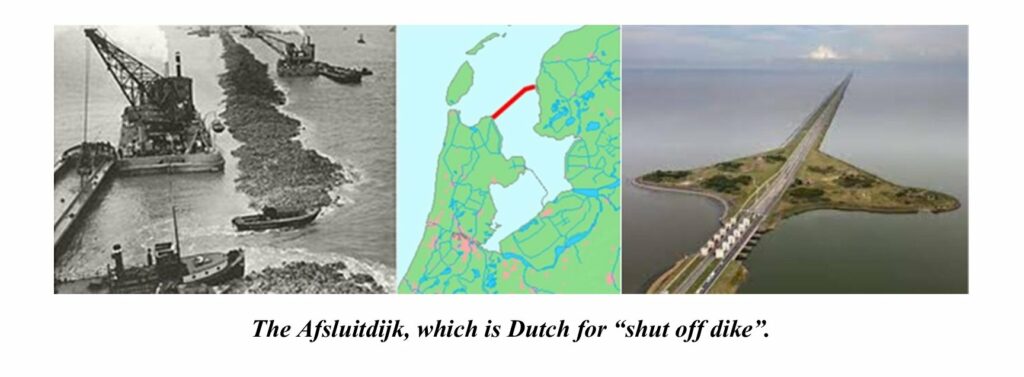
In 1932 the Dutch completed what they call The Afsluitdijk, which is Dutch for “shut off dike”. It stretched across the top of the Zuiderzee and created a large lake and as several rivers were flowing into it, it soon became a freshwater one.
It was completed 89 years ago, even though the project had originally been talked about in 1886, when a group called The Zuiderzee Society started to investigate the possibility of reclaiming land from the Zuiderzee. The main driving force was a man called Cornelis Lely, who in 1891 came up with the idea to enclose the Zuiderzee and then create large Polders. Since the 12th Century, the Dutch had been creating arable land, which they called Polders, by draining swamps into nearby rivers. His idea was simply to do this on much larger scale.
Until this time the Zuiderzee had acted as a protected entrance and exit for the harbour of Amsterdam and several other Dutch ports, allowing them to benefit from Holland’s golden age of trade, while at the same time providing good safe local fishing grounds.
However, things were changing. The sea had become overfished, they had built the North Sea Canal, linking Amsterdam directly to the North Sea, while at the same time the population was growing, therefore, to feed the people they needed more agricultural land. Finally, as for centuries the Dutch had been building Polders, they weren’t worried about doing it on a larger scale.
In 1913, Lely became Minister of Water Management and immediately put forward his plan. Unfortunately, due to the huge cost involved, it was opposed. Then, in 1916 there were huge floods, followed by a famine in 1918, opinions changed and the project got the go ahead.
It took until 1927 before ten thousand workers, 27 large dredges, 13 floating cranes, 132 barges, and 88 tugs actually started to work on the Dike, which they completed within five years. Then on 28 May 1932, the Ijsselmeer was born.
They then went on to create large Polders, and interestingly found that the land under the sea was incredibly fertile. Furthermore, and this is the interesting bit, today nearly half of the Netherlands is made up of land reclaimed from the sea.
Finally, they built a city in the Polders and called it Lelystad, after, guess who?
But don’t think this is the first time the Dutch have reclaimed land they have been doing it for centuries, currently around one third of Holland is below sea level.
Isn’t History Interesting?
10 questions to discuss:
- What does “Afsluitdijk” mean in English?
- What major body of water did the Afsluitdijk separate from the North Sea?
- Who first proposed the idea of enclosing the Zuiderzee and creating polders?
- How did the North Sea Canal impact the need for the Afsluitdijk?
- What were the primary reasons for building the Afsluitdijk?
- What major events helped convince the Dutch government to approve the project?
- How many workers and machines were involved in constructing the Afsluitdijk?
- What discovery did the Dutch make about the land reclaimed from the Zuiderzee?
- What percentage of the Netherlands is currently land reclaimed from the sea?
- What city was built in the polders created by the Zuiderzee Works and who was it named after?
To learn more about this go to:
https://blogs.transparent.com/dutch/de-afsluitdijk-enclosing-the-sea/
https://dutchreview.com/culture/society/how-the-dutch-built-cities-on-sinking-land/
https://www.modernhistorymaps.com/post/making-land-from-water-dutch-land-reclamation-on-maps
© Tony Dalton
Lorem ipsum dolor sit amet, consectetur adipiscing elit. Ut elit tellus, luctus nec ullamcorper mattis, pulvinar dapibus leo.

